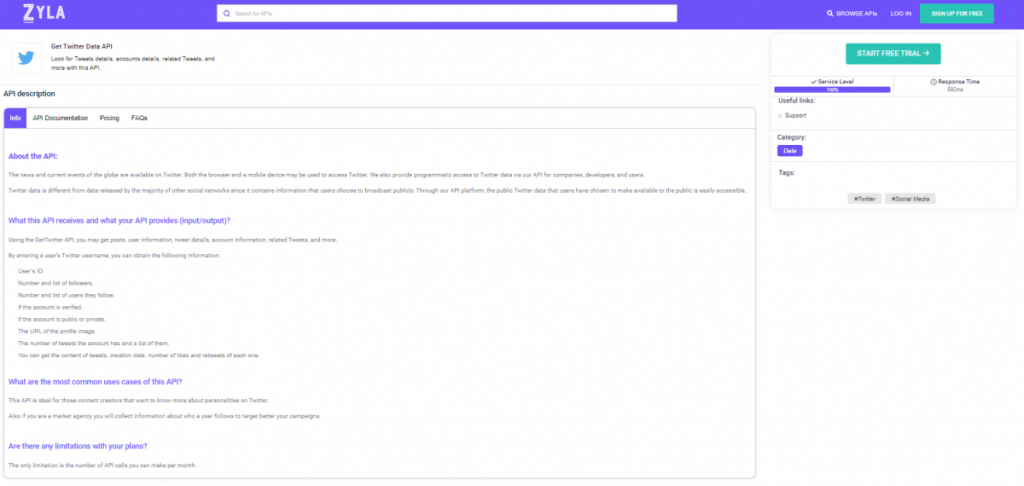Twitter is a goldmine of valuable data that can provide insights into user behavior, sentiments, and trends. To access this wealth of information, you can leverage an API specifically designed to retrieve data from Twitter. In this article, we will walk you through the steps of obtaining Twitter Data using an API, allowing you to harness its power for various purposes such as social media analysis, market research, and more.

Some Twitter Data API Basics
API Registration and Authentication: The first step in getting Twitter data from an API is to register for the API and obtain the necessary credentials. This usually involves creating a developer account, setting up an application, and generating API keys. These credentials are essential for authenticating your requests and ensuring secure data retrieval.
Understanding API Endpoints: APIs provide different endpoints that allow you to access specific types of data. These endpoints serve as the entry points for making requests and retrieving the desired information. Examples of common endpoints include retrieving user details, searching for tweets, accessing trends, and more. Familiarize yourself with the available endpoints and their functionalities to make the most out of your data retrieval process.
Making API Requests: To retrieve data, you need to make API requests using the appropriate HTTP methods (such as GET, POST, or DELETE) to the specified endpoints. These requests may include parameters such as search keywords, user IDs, or location coordinates, depending on the type of data you want to retrieve. Construct your requests properly by including the necessary parameters and headers for successful data retrieval.
Handling Rate Limits: Twitter APIs often have rate limits in place to ensure fair usage and prevent abuse. These rate limits define the maximum number of requests you can make within a specific time frame. It’s crucial to understand and respect these limits to avoid disruptions in your data retrieval process. Consider implementing strategies such as efficient data batching, caching, or using multiple API keys to work within the allowed rate limits.
Data Parsing and Analysis: Once you receive the data from the API, it’s essential to parse and analyze the data effectively. Depending on your requirements, you may need to extract specific information from the retrieved data, such as user profiles, tweet content, engagement metrics, or sentiment analysis. Utilize suitable programming languages, libraries, or tools to process and analyze the data in a meaningful way.
Check to Get Twitter Data API
Consider exploring the Get Twitter Data API provided by Zyla Labs for seamless access to a wide range of Twitter data. This API seamlessly integrates into your applications, offering real-time updates on tweets, users, and trends. With its flexible data retrieval options based on keywords, users, or locations, it caters to various use cases. Whether you’re a social media analyst, news organization, marketer, or developer, the Get Twitter Data API provides valuable insights.

Although there is a monthly call limit, the Get Twitter Data API remains a reliable solution for accessing publicly available Twitter data. Retrieve user information, tweet details, follower counts, and more to enhance your understanding of Twitter dynamics and improve your strategies. Expand your capabilities and unlock valuable insights with the dependable Get Twitter Data API from Zyla Labs.
How To Use It?
- First, go to Get Twitter Data API and press the “START FREE TRIAL” button.
- Then, you’ll be able to use the API after joining Zyla API Hub!
- Send a request to the API in the endpoint needed.
- Finally, you will receive an API response.
The API provides six endpoints for working with Twitter data: /user_details, /tweets_per_user, /who_is_the_user_following, /user_followers, /tweet_details, and /search_tweets_by_sentences/words.
/user_detailsgives information about a user, such as their username, bio, and location./tweets_per_userthis endpoint gets a list of tweets for a user./who_is_the_user_followingwith this, you will retrieve a list of users that a user is following./user_followersis useful to get a list of users that are following a user./tweet_detailsendpoint gives information about a tweet, such as its text, timestamp, and location./search_tweets_by_sentences/wordsendpoint searchs for tweets that contain a specific sentence or word.
These endpoints can be used to get information about users, tweets, and their relationships. This information can be used for a variety of purposes, such as social media analytics, marketing research, and customer support.
For example, if you try the User Details endpoint to get data on Elon Musk, you will get a response like this:
{
"creation_date": "Tue Jun 02 20:12:29 +0000 2009",
"user_id": "44196397",
"username": "elonmusk",
"name": "Elon Musk",
"follower_count": 145114901,
"following_count": 339,
"favourites_count": 26451,
"is_private": false,
"is_verified": false,
"is_blue_verified": true,
"location": "",
"profile_pic_url": "https://pbs.twimg.com/profile_images/1590968738358079488/IY9Gx6Ok_normal.jpg",
"profile_banner_url": "https://pbs.twimg.com/profile_banners/44196397/1576183471",
"description": "",
"external_url": null,
"number_of_tweets": 27374,
"bot": false,
"timestamp": 1243973549,
"has_nft_avatar": false,
"category": null,
"default_profile": false,
"default_profile_image": false,
"listed_count": null
}If you want to learn more, check How To Leverage A Twitter Data API To Get Business Insights

